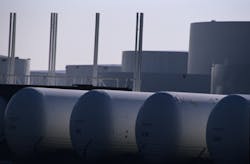The following post originally appeared on Automation Products Group’s blog.
Pressurized tanks make level measurement a little more difficult — it just comes with the territory. So what kinds of sensors work well in pressurized environments? How can you compensate for the static pressure of the vessel?
First, you need to recognize whether or not your tank or vessel is pressurized.
For vaporous liquids, tanks often have a pressure-relief valve that avoids building up too much pressure in the tank while keeping it isolated from the outside world. This is a good way of keeping flammable liquids protected from ignition sources.
From time to time, we’ll have a customer call in with problems, only to realize that they have a pressure-relief valve that is holding pressure inside the tank. Either they didn’t realize it, or they don’t consider it a true pressurized vessel (semantics). But as far as the sensor is concerned, pressure is pressure.
A submersible pressure transducer by itself will have a hard time with a pressurized vessel as it uses pressure and specific gravity to infer a level measurement. The added static pressure is seen as additional feet of liquid.
An ultrasonic sensor has difficulty as well — simply because the housing material isn’t capable of withstanding high pressure. For our sensors, anything above 30 PSI could cause the threads to fail, creating a projectile out of the sensor.
What sensors work?
There are a few sensors that work well for pressurized tanks. They are those that have a heavy-duty housing to withstand the pressure and are either unaffected by the static pressure, or can compensate for it effectively.
Our resistive chain and magnetostrictive level probes have a heavier duty build that can withstand up to 150 PSI. While they are more expensive than several other options, they fall middle-of-the road in terms of list price—more than ultrasonic, but less than radar. However, they are costly to ship and install due to their long stems and weight.
READ ALSO: How Logic Solvers Can Cut Costs & Simplify Your Tank Overfill Protection SIS
Despite the extra costs, they are well suited for many level measurements because they measure level directly with a float and are quite accurate. Unlike other technologies, they provide a reliable level reading with very few exceptions.
Finally, what is most used for pressurized tanks is a differential-pressure reading. Installing two pressure sensors — one at the bottom of the tank and one at the top — will allow you to subtract the influence of the static pressure and normalize the level reading.
How to compensate for static pressure
It might take a little math, but compensating for static pressure is a relatively simple process. At its core, you’re simply subtracting the static pressure from the total pressure at the bottom (static + liquid column).
Of course, you have to calibrate the sensor for the right variables like span and specific gravity. (For a good article on this topic, go here.)
Kelvin Findlay is an industry analyst and marketing manager at Automation Products Group Inc. He is deeply involved in APG’s pressure and level measurement product lines for the Oil and Gas, Water and Wastewater, and Chemical industries. His passion for understanding how and why sensors are used in the field drives his research and APG’s product development.
Automation Products Group Inc. (APG), is an ISO 9001 certified manufacturer, specializing in liquid level sensor and pressure transducer design and manufacture. The company offers pressure transducers that would allow you to perform the differential measurement details in the above article. For more information, go here.


